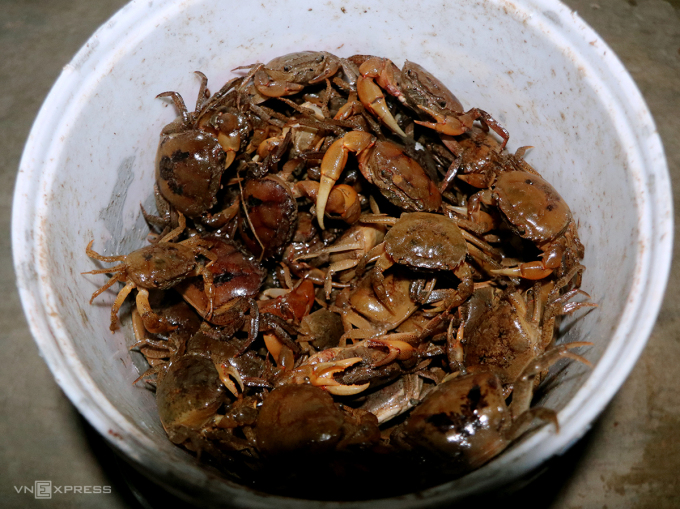The profession is only enlisted at night, the income is higher than rice farming
Many farmers in Ha Tinh take advantage of the night to go to the fields to catch crabs. Side work but brings
HA TINH – People in Cam Xuyen and Thach Ha districts wade through the fields at night to catch field crabs and process them for food, or sell them for 70,000-90,000 VND/kg.($1=25,000 VND)
In the early evening of December, Mr. Pham Ba Tien, 50 years old, residing in Phuc Son village, Cam Son commune, Cam Xuyen district, wearing boots, protective gear, flashlight, plastic bucket, knife, and 5-6 neighbors driving motorbikes drove each other to the fields about 2 km away from the house. Setting up their cars on the road, people stepped down into the fields, radiating in all directions to catch field crabs.
The ditch beside the field has many caves of field crabs. The cave is 7-10 cm in diameter, 20-30 cm deep, and about a meter away, one appears. At night, field crabs often go out to find prey, which is the time when hunters set traps.
Wading along the ditches and the field that had just been harvested, Mr. Tien watched attentively, whenever he saw a crab under the water, he immediately stooped down and put it in a plastic bucket. On average, every four steps, he caught one, fortunately, met 2-3 at a time. A flashlight flashed across an area.
“Hunters must move gently and monitor every movement. Crab is very sensitive to the surrounding space, if it detects danger, it will crawl into the cave or hide under the mud immediately”, Mr. Tien explained.
With the crabs hiding in the cave, Mr. Tien often wades into the ditch, stooped to take a knife worn on his waist to clear the surrounding vegetation, then put his right hand deep inside, swishing a few times to catch it.
In caves and underwater, snakes and leeches often appear. To prevent being bitten, people often buy flashlights with high brightness for easy detection, in addition, they must wear knee-high boots and plastic gloves. “If you accidentally catch a snake, you need to calm down, don’t attack them again. A few years ago, someone in the district was bitten by a poisonous snake while catching crabs. Fortunately, they were taken to the hospital in time, so they did not have to wait. life-threatening,” Mr. Tien said.
Hunting crabs is a part-time job of Ha Tinh people. Crabs spawn all year round, but the most in April-June and October-December of the lunar calendar. On these two occasions, crabs often eat the scattered rice grains, so they are fat, larger in size and many bricks.
According to Mrs. Nguyen Thi Thuan, 52 years old, residing in Thach Ha district, this time the farmers are idle, in the evening people often take advantage of the field to catch crabs to sell, earn more money to cover their lives. There are families that mobilize 4-5 members to participate.
Every night, from 6.30pm to 9.30pm, Mrs. Thuan and her daughter caught more than 5 kg of field crabs in fields near her house in Viet Tien commune, selling 70,000-90,000 VND per kg. “If you work hard, you can also get nearly 500,000 VND”, Mrs. Thuan smiled, sharing that this profession is low cost, just need to invest more than 400,000 VND to buy a flashlight, plastic bucket and some protective tools. -2 seasons.
“Crab has two types, purple and yellow. Yellow crab is always favored by traders because of its soft meat. Purple is foreign crab, there are large sized ones, weighing more than 100 grams, but rarely in the field. rice,” said Mrs. Thuan.
On average, every night when hunting, Ha Tinh farmers catch 5-7 kg of field crabs, if a family has a lot of manpower, they will collect 10-15 kg, selling 500,000 to more than a million dong. In each commune, there are always 1-2 traders who collect and buy field crabs, buying 100-300 kg per day. They then bring them to partners in the area, or hire trucks to take them to the North to deliver to restaurants and pubs.
The scientific name of the crab is Somanniathelphusa sinensis , and in some localities, it is called the dam or fill the prize. This species lives in the bottom of fresh water, adapted to clay and sandy mud. Field crabs have many healthy nutrients and are processed in many dishes such as soup, hot pot, vermicelli, fried crab with fat…
Photo: Internet (vinlove.net)

